In Psychology, our research involves many different types of equipment and techniques. Undergraduate students are involved in all aspects of the research process, working alongside postgraduate students or academic staff. A few of our research facilities are highlighted here.
Functional and structural magnetic resonance imaging (MRI):
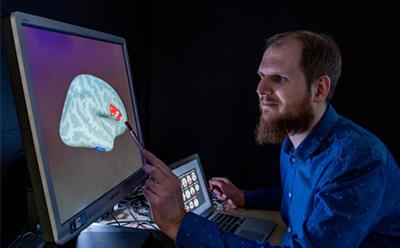
We use MRI to understand the neural correlates of perceptions, behaviours and individual differences. For example, Dr Dennis Golm investigates the correlates of childhood maltreatment (i.e. severe neglect experienced in institutions) to understand how exposure to early adversity can lead to mental health problems. This research can inform new treatments and interventions for looked-after and adopted children with a history of maltreatment. Here, Dr Dennis Golm is looking at volumetric changes in the inferior frontal cortex.
Neurostimulation Lab:
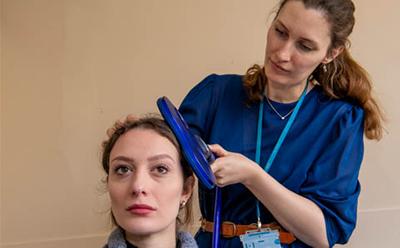
We use transcranial magnetic stimulation (TMS) and direct current stimulation (tDCS) to modulate cortical networks involved in cognition, emotion processing and behaviour. Here, Dr Valerie Brandt, applies TMS to the pre-motor cortex in a healthy participant. Our lab tests whether TMS/tDCS can provide new treatment options for a range of conditions, including TIC disorders, anxiety and depression.
Psychopharmacology Lab:

Here were examine the effects of pharmacological drugs and medicines on psychological function. Shown here, Professor Matthew Garner prepares a participant for the 7.5% carbon-dioxide challenge – an experimental model of anxiety that mimics in healthy volunteers the subjective, autonomic and neuropsychological characteristics of anxiety. We have successfully used experimental medicine models to evaluate new treatments for anxiety disorders and comorbid conditions.
Psychophysiology:
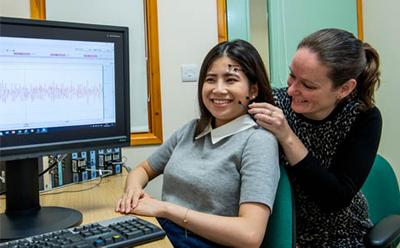
In our psychophysiology labs, physical responses to different stimuli or events can be measured, such as heart rate, skin conductance, respiration rate, and the use of facial muscles (e.g. smiling). For example, Dr Claire Hart, pictured here, uses facial electromyography (fEMG) to examine individual differences in the extent to which people mimic the emotions of others.
Observation lab:
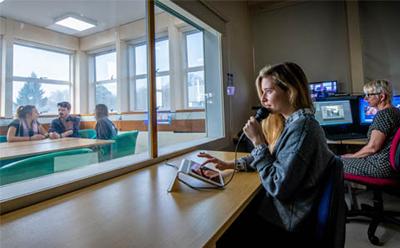
A one-way mirror between adjoining rooms allows us to view participants, and we can also record their interactions. This lab is used in studies of social interactions. For example, strangers might be given a shared task to complete, allowing us to investigate the relationship between personality traits and rapport building.
EEG:
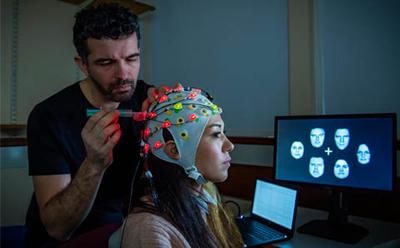
We have multiple active electrode Electroencephalography (EEG) set-ups that can be used to simultaneously measure brain activity from up to 128 different sites across the scalp. EEG is particularly useful for understanding the temporal dynamics of neural activation in response to experimental manipulations.
Eye movement recording:
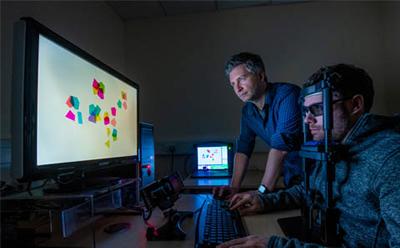
We have several different eye trackers, for use with static or moving observers. Dr Hayward Godwin uses EyeLink recorders to understand how observers search for visual targets. This observer is wearing shutter glasses, which allow us to present different stimuli to each eye, so that stimuli are presented with stereoscopic depth.
Virtual reality (VR) lab:
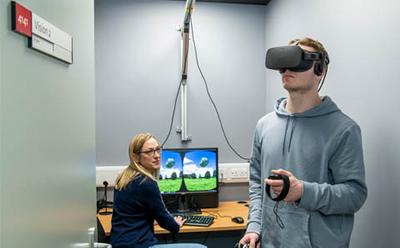
Participants are immersed in a virtual, multisensory environment. The observer’s head position is tracked, so that they move around the environment the visual scene is updated accordingly. This gives a strong sense of presence in the virtual environment. The VR headset also provides auditory stimulation and vibrotactile feedback is delivered via hand-held controllers that also track the participant’s hand positions. This equipment has many applications; for example, Professor Wendy Adams uses it to understand visual and multisensory perception of shape and material properties.
Visual-haptic lab:
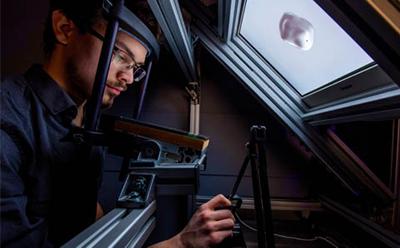
Participants simultaneously look at and ‘touch’ virtual objects. A force-feedback device attached to the participant’s finger allows us to mimic the sensation of exploring an object that can be hard or soft, sticky or slippery and smooth or rough. By viewing the visual stimulus via a mirror, the subject is convinced that they are looking at and touching one object. Professor Wendy Adams uses this lab to explore how humans combine vision and touch to estimate shape and material properties such as gloss and friction.
Stereoscope:
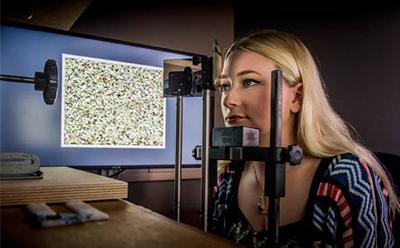
This mirrored set-up allows us to present slightly different images to each eye, with very high spatial and temporal resolution. Professor Wendy Adams and Dr Erich Graf use this equipment for experiments that explore how the human visual system uses binocular depth cues. For example, binocular depth cues are used to overcome the effects of camouflage when we are searching for a target object, like a snake in leaves.
Pain lab:
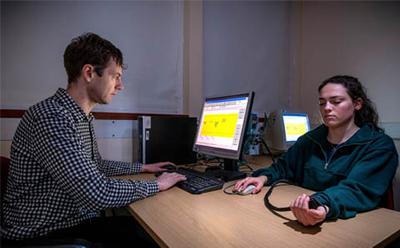
The Pain Laboratory includes a TSA-II Neurosensory Analyser, allowing us to present highly repeatable stimuli (e.g. heat, cold or vibration) and to measure participants’ responses to these stimuli.
For example, Dr Daniel Schoth (pictured here) investigates the relationships between chronic and acute pain and cognitive factors such as attentional biases.
Mobile Research Unit:

The MRU is a custom-fit vehicle that allows us to bring carefully calibrated equipment, such as eye movement recorders, into different communities. For example, we can visit schools and colleges to enhance our outreach activities and participants of all ages can get involved in our research without travelling to the university campus.
The Colour Lab:

When you step into our colour lab you might be surprised that everything is pitch black rather than colourful. This is done to very precisely control all unwanted stimulation that would affect colour perception. We use one of the best spectroradiometers to measure the exact wavelength spectra of the light that reaches the eyes and triggers the complex cascade of perceptual processes that culminates in our perception of colour. In addition, high-end computational equipment allows us to calibrate displays with highest precision. We use standardised colour chips to investigate the effects of lighting on surface colours. Through colour-deficiency tests, we control for known variation of colour vision across the participants in our experiments.
For more information about the research that we do, please visit our research page, or browse some of our recent publications.